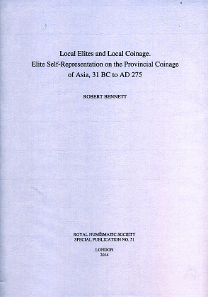by Ursula Kampmann
translated by Annika Backe
June 4, 2015 – Cui bono? – To whose benefit? – This is an old question that is at the heart of every crime thriller. Historiography, and hence numismatics, poses this question since recently, and yet it is the initiator of a work, a coin who largely shapes its message. In his book, which has been published by the Royal Numismatic Society as part of its Special Publications series, Robert Bennett examines the elite of Asia and its influence on the civic coinage.
Robert Bennett, Local Elites and Local Coinage. Elite Self-Representation on the Provincial Coinage of Asia, 31 BC to AD 275. Royal Numismatic Society Special Publication 51. Royal Numismatic Society, London, 2014. 201 p. and 31 b/w plates. 22 x 30.5 cm. Hardcover. ISBN: 0-901405-79-5. 50 GBP + plus shipping costs.
Some coins of Asia record ‘coin officials’, hence members of the upper stratum that are in some way involved in the issuing of this emission. Bennett’s book aims to thoroughly determine their role and their representation in the choice of images on coins. To this effect, the author firstly addresses the issue of what exactly constituted the civic elite in Asia. What part did the boulé, the council of citizens, play? To what extent were Roman citizens involved, too? What honorary functions did they hold? The picture Bennett is sketching is that of an international elite that exerted its influence in its home town, yet likewise held honorary functions in the province, even in the Roman administration.
The next chapter deals with the role of the ‘eponyms’ on coins, thus the men recorded in various coin legend formulae as they have been known already in Greek times. Does this reflect a shift in meaning, from a mere dating of the coinage to a funding of the coinage? What can be said about the relation of privately and publicly funded coinage?
The coin legends are followed up by the images. The author takes the coinage of Thyateira and Laodicea on the Lykos as a basis to ask for the practical reasons that affected the choice of images. He stresses that the mobile mints, which had been proven to exist by Konrad Kraft as early as the 1970s, had a great influence on the imagery on the coinage, notably on its smaller denominations.
The images on the large, gorgeous medallions, in contrast, can be linked with the civic repertoire. Did the sponsors choose these images independently? There is no reflection, hence no secure proof, of this in the legends but this is perhaps how it happened.
Many coin images mirror the priorities and the career steps of the eponyms though. The large emissions that are connected with the coin officials are studied in the last chapter preceding the summary.
An appendix comprises a catalog of all coin eponyms that are recorded in legends and literary sources.
The next two appendices will prove highly useful to all those who have to identify coins. All coin types from Thyateira and Laodicea that are currently known thanks to RPC projects are listed here. With a major part of the material being accessible online only, the book by Bennett may well be taken as a new standard work of reference on the coinage of these two cities in the Roman Imperial period.
A rather comprehensive plate section, with 31 leaves of plates, illustrates the author’s theses and provides rich material, mainly from Thyateira and Laodicea.
In sum, this is another pleasing result of the RPC project that assembles the coins from Roman Imperial times. Only with a broad basis of material can fundamental questions be answered. The book by author Robert Bennett is a welcome contribution to the ongoing debate on the role of the provincial coinage of cities in Asia. It gives a superb insight into the agendas and priorities of an elite which became more and more international and which used the coinage as a means to set a monument to their city and hence themselves.





